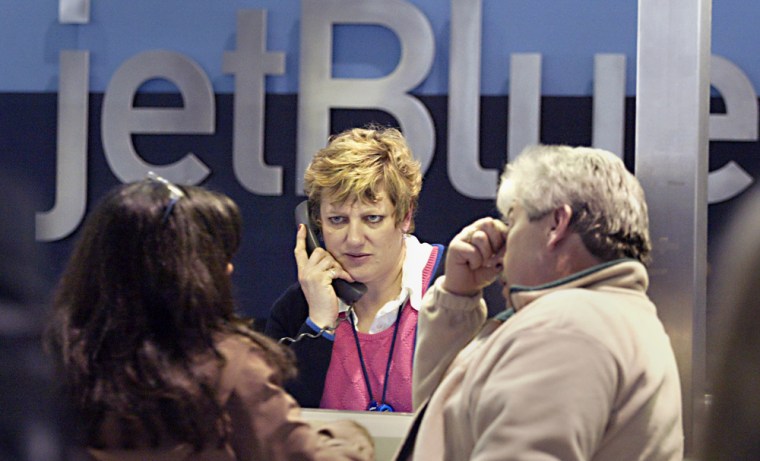How do you turn a profit and make the customer happy at the same time, especially with less staff and fewer available seats?
That question is front and center of late for the slimmed-down airlines with flight delays, computer glitches, lost baggage and weather-related problems getting more attention. Airlines started the week still struggling with delays and cancellations caused by an ice storm in the Northeast over the St. Patrick’s Day weekend, and on Wednesday, JetBlue Airways Corp. lowered its 2007 profit outlook, partly because of a rash of weather-related cancellations.
There’s only so much the airlines can do when it snows or ice freezes the runways, and system malfunctions can happen from time to time. But with the airlines laser-focused on controlling costs and turning profits, customers have a right to expect more for their money, travel watchers say.
“We’ve had a race to the bottom in the airline industry to see who can operate an airline with the least amount of people,” said Terry Trippler, a Minneapolis-based airline expert. “I don’t know which airline has won, but I know the consumer has lost.”
The number of total employees fell from 672,294 at the end of 2000 to 529,590 at the end of 2005 among U.S. carriers designated as major airlines by the Department of Transportation’s Bureau of Transportation Statistics. Meanwhile, government data shows U.S. carriers did a poorer job of on-time performance and baggage handling in January compared to a year earlier. The 20 airlines reporting had an on-time arrival rate of 73.1 percent in January, down from 78.8 percent a year earlier, and 8.19 reports of mishandled baggage per 1,000 passengers, up from 6.93 a year ago, according to the DOT.
David Castelveter, a spokesman for the Air Transport Association, said it’s unfair to blame airlines for things that are often beyond their control — like weather-related delays. And while he acknowledged major airlines have reduced capacity and cut staff in recent years, he said they haven’t lost sight of the importance of good customer service.
“I think it is a convenient argument for people to make that downsizing has increased delay times,” Castelveter said. “I find that to be unsubstantiated.”
He said that while having fewer available seats doesn’t always provide for a customer to quickly get to his or her destination when a flight is delayed or canceled, “there are many cases where there are seats available.”
Widely publicized gaffes lately have not made things easy for the airlines.
New York-based JetBlue suffered a public relations fiasco after a storm on Valentine’s Day caused widespread operational delays. The airline, which could not resume a normal schedule for days, adopted a customer bill of rights after reports that passengers were stranded for hours on grounded planes.
Earlier this month, Tempe, Ariz.-based US Airways Group Inc. was affected by computer glitches that started shutting down hundreds of check-in kiosks. Problems with self-service kiosks in several cities began after the airline put a new computerized reservation system in place. The malfunctioning kiosks resulted in an unspecified number of flight delays.
JetBlue spokeswoman Alison Eshelman said it’s reasonable for passengers to expect a lot from the airlines.
“We want to hold ourselves to very high standards,” she said. “When there are weather delays, they can know exactly what to expect from us.”
US Airways’ Phil Gee said airlines should be prepared to handle any situation.
“We’re in the customer service business and the customers expect good customer service every time they fly,” he said.
They also want low fares.
Dawn Van Meeteren said her family wouldn’t want to pay more for a ticket, even if it means fewer delays.
“It’s expensive now as it is!” the Bellflower, Calif., woman said while standing in the baggage claim area of Los Angeles International Airport after a recent US Airways flight from Houston.
Besides, sometimes delays bring perks. Her brother Timothy once got bumped up to first class and received a discounted ticket for the hassle.
“Things happen and you can’t control them all the time,” Timothy Van Meeteren said.
One of the things the airlines can do is be proactive, especially when preparing for inclement weather, said James Whitehurst, chief operating officer of Atlanta-based Delta Air Lines Inc.
“We shouldn’t have excuses as airlines,” Whitehurst said. “We know weather happens. We need to have processes in place. We need to have contingencies in place.”
“I don’t want to say we can always fly through a storm,” he noted, but then added, “It’s up to us to invest in the technology and the processes so we can recover quickly.”
Whitehurst said on-time performance is ultimately about execution.
“In the end, the root cause of why we are in bankruptcy is because we lost sight on the customer,” Whitehurst said.
The company’s reorganization has led it to focus more on service.
“The good news from our perspective, we’ve been out of the press because we’ve been delivering better,” Whitehurst said.
